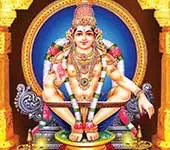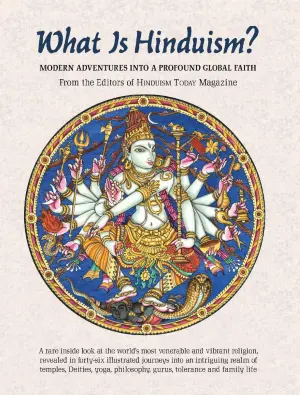What Is Hinduism?
This book which explains the basic tenets and beliefs of Hinduism is an invaluable resource for anyone interested in learning about this universal religion. Hinduism is one of the world's oldest religions, with a rich history and a diverse set of beliefs and practices. At its core, Hinduism is based on the idea of dharma, or duty, which encompasses everything from personal morality to social responsibility.
Click here to read PDF Book
Recommended for you
Can Spirituality Not Wait Till Retirement?

Is spirituality something that can only be pursued in retirement? This thought-provoking piece challenges that notion....
Click here to know more..What you should and should not sit upon while chanting mantras
 Click here to know more..
Click here to know more..
Shabaressha Ashtakam

ओङ्कारमृत- बिन्दुसुन्दरतनुं मोहान्धकारारुणं दीनानां श�....
Click here to know more..Excerpt
Excerpt
AIl faiths are grappling with their self-definition as we rev up to the breathtaking speed of the information age a period more intense and kinetic than any other in the history of the world. Teachings and practices that were once accepted without question are often now rejected unless evidence and logic are marshaled to give them plausibility. To survive, customs and traditions must bear up under intellectual scrutiny, and must prove themselves helpful and immediately usable. Hinduism is no exception. Hindu education for youth is languishing, and communities around the world are struggling to compose clear, concise presentations of the dharma. It would be possible to spend an entire lifetime, indeed, many lifetimes, absorbing and practicing the teachings of just one sect of the Hindu faith. Yet, there is also a need to understand this complex conglomerate as a whole as well. There is a preeminent need, the world over, for cogent, comprehensive explanations of the various facets of Hinduism and the shared features of its various sects from a mountaintop perspective to answer the sincere questions of children, coworkers, neighbors, critics and colleagues, and to provide a non-academic presentation for those of other religions seeking in sight into this ancient path. Producing quality educational materials on Hinduism is - inherently difficult precisely because it is one of the world's most paradoxical and easily misunderstood religious traditions. It can be equally confounding to the outsider and to those born in dharma's embrace. This is because it is actually a family of many different faiths that share essential practices and characteristics.
Most Hindus have an intuitive sense of, but can't articulate, the whys and wherefores of their philosophy and practices. The boldness to ask questions about such matters has only recently developed. Just confer with Hindu parents who have stumbled when confronted with the direct and innocent questions posed by their own children, questions they never voiced and therefore never learned satisfying answers to.
This book seeks to be a bridge between generations of past centuries that grew up immersed in a pristine Hindu culture- with vast communal knowledge available to them-and current generations that have little or no access to such knowledge. In those olden times, living in a homogenous society with the faith's culture and traditions interwoven in every aspect of daily life, one didn't need to ask the whys of everything, Ile only needed to participate, enjoy and absorb the nuances and meanings from the inside out. In today's fragmented societies, we no longer have such cocoon-like training for children, so teachings must be rearticulated and presented in ways that will make intellectually clear their purpose, relevance, and value in competition with the compelling flood of media that youths and adults are subjected to day after day. Hinduism must also compete in the arena of ideas with its aggressively evangelical counterparts. The idea of creating a book called What Is Hinduism? came to me from the inner sky one day while I was meditating on our faith's educational needs. It was as if the inner-plane masters, among them our dear Gurudeva, Satguru Sivaya Subramuniyaswami, were sending the thought form that such a work would be just what is needed at this time. Approached from scratch, the book in your hands would take years to produce, especially with the amount of patience and care that you will find here in each chapter. Thus, the serendipitous beauty of the project was that the necessary thousands of hours of loving attention had already gone into researching and designing its chapters, as Educational Insight sections over the last ten years by the talented team of editions, writers and photographers of our international magazine, HINDUISM TODAY. All that was needed now, in 2007, was to choose the best features and put them together in a way that offers a thorough yet highly readable introduction to Hinduism. Voilà! As a small group of renunciate Hindu monks at Kauai's Hindu Monastery in Hawaii, we have produced HINDUISM TODAY for more than a quarter century, tracking, monitoring and encouraging the current renaissance of the grandfather faith of the human race. One of the main reasons Gurudeva founded the magazine was to help Hindus become more aware of the activities of their Hindu brothers and sisters in other parts of the world and thus draw strength and courage from that knowledge. Another was to dispel myths and misinformation promulgated by invaders and missionaries of alien religions. A third was to present the beliefs and practices common to all Hindus, as well as the teachings and traditions of the individual sects, traditions and lineages that together form this quilt of dh arma. What Is Hinduism? is an insider's view, honoring the beauties of culture, tradition, celebration, worship, belief, and discipline.
In addition to the reams of scripture available to readers, there are many books on Hinduism by writers and scholars of both East and Wests But few offer much relief to the parent looking for simple answers, or the social studies teacher looking for an authentic overview of the faith. Texts by Westerners, often academic in nature, tend to paint Hinduism into the past and distort it with the wrong emphasis, dwelling on peripheral, controversial issues such as caste and the Aryan Invasion. Those by Easterners generally focus on just one sampradaya or lineages such as Sankara Vedanta, Madhva Vaishnavism, or Saiva Siddhanta-often presenting its philosophy and tradition as if it were the whole of Hinduism, which, of course, it is not. When each sect and lineage is presented in this way, it is no small wonder readers get confused.

English Topics
Spiritual books
Click on any topic to open
- 30 Adhyatma Ramayana - English Translation
- 29 Kathakali - The Dance Of Kerala
- 28 Varanasi Down the Ages: Tracing the Evolution of India's Spiritual Capital
- 27 Vedas With Meaning
- 26 Valmiki Ramayanam
- 25 Sapthagiri - January - 2019
- 24 Vedas On Marriage - Emancipation Of Woman
- 22 Scientific Hindu
- 21 What Is Hinduism?
- 20 Antyeshti - Death Rituals
Please wait while the audio list loads..
30
Ganapathy
Shiva
Hanuman
Devi
Vishnu Sahasranama
Mahabharatam
Practical Wisdom
Yoga Vasishta
Vedas
Rituals
Rare Topics
Devi Mahatmyam
Glory of Venkatesha
Shani Mahatmya
Story of Sri Yantra
Rudram Explained
Atharva Sheersha
Sri Suktam
Kathopanishad
Ramayana
Mystique
Mantra Shastra
Bharat Matha
Bhagavatam
Astrology
Temples
Spiritual books
Purana Stories
Festivals
Sages and Saints

